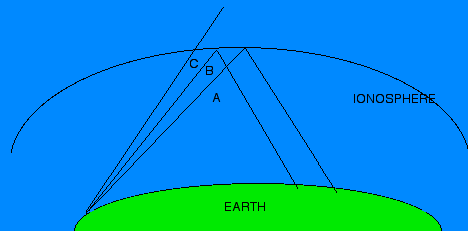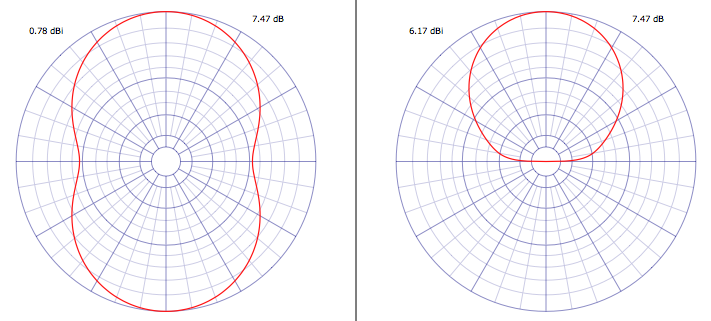While shortwave radio is commonly thought of as being used for long distance communications, it also functions for local and medium distance links. This is accomplished by a method known as NVIS, or Near Vertical Incident Sky Wave, and is in fact what most US pirate operators are using, even if they have never heard of it before.
I touched on NVIS in my previous post Going Long, which readers may wish to read before continuing.
To summarize, the ability of HF radio waves to get from the transmitter to target location depends on the ionosphere being able to refract (or reflect) them back to the Earth. The stronger the ionization level, the higher the frequency that can be refracted back, as most radio enthusiasts know. This is why during periods of high solar activity, the higher bands (up to 30 MHz and even beyond) are useful for long distance communications during much or even all of the day. Whereas when solar activity is low (as it has been until recently) the higher frequencies are often dead, and lower frequencies must be used.
But there’s a second factor as well – the angle that the radio waves strike the ionosphere. For a given ionization level, the lowest maximum frequency that can be reflected occurs when the radio waves are directed straight up. In this case, they would be reflected right down, for local reception. As the radio waves strike the ionosphere at more shallow angles (as would be the case for waves that are going to reach the Earth further away), higher frequencies will be reflected.

In the above picture, paths A and B are at shallow enough angles that the radio waves get reflected back to the Earth. For path C, the angle is too steep, and the radio waves are not reflected, but pass into space.
The maximum frequency that will be reflected straight back is called the foF2 frequency. It is continuously varying, based on solar activity, and what part of the Earth the Sun is over. You can find a real time map at this URL: http://www.spacew.com/www/fof2.gif

During the daytime, it lately has been reaching 10 or 12 MHz over the USA. At night, it drops down to 3 or 4 MHz.
The angle that the radio waves strike the ionosphere depends on the distance between the transmitter and receiver, and the height of the ionosphere, which unfortunately also varies. This is called the hmF2, and there’s a real time map of it also: http://www.spacew.com/www/hmf2.gif

The Maximum Usable Frequency (MUF) can be found by:
MUF = foF2 * sqrt( 1+ [D/(2*hmF2)]^2) where D is the distance in km.
Obviously, if the foF2 frequency is above your transmitter frequency, you don’t need to worry, you’ll be able to operate NVIS and be heard (assuming you have enough power to overcome noise, of course)
Once foF2 drops below your operating frequency, radio waves directed straight up keep going into space. Waves at more shallow angles (reaching the earth some distance away) could still be reflected, depending on the geometry. This creates what is referred to as the skip zone, the distance around the transmitter where the signal cannot be received.
For example, assuming a hmF2 height of 300 km (fairly average) here’s the skip zone distance for several different foF2 values, for a transmitter frequency of 7 MHz:
3 MHz 1270 km
4 MHz 860 km
5 MHz 580 km
6 MHz 360 km
As I type this at 0030Z on December 15, 2011, foF2 has dropped to 5 MHz over the northeast US. This leaves an approximately 350 mile diameter skip zone around the transmitter, where the broadcast cannot be received.
For good NVIS operation, an operator wants most of the transmitted RF to go straight up. This suggests the use of simple antennas like dipoles at low heights, which as it turns out is what most operators are doing anyway. A 43 meter band dipole at 30 feet up has radiation patterns like this:

The graph on the left is the pattern around the points of the compass, and the one on the right is the elevation. As you can see from the graph on the right, most of the RF energy is going up. This is bad for long distance DX, but good for NVIS operation.
The key point to remember is that when the band closes for NVIS, you will lose your local audience, where local could mean a radius of several hundred miles around your station. Dropping to a lower frequency (like 5, or even 3 MHz which operators have used in the past) regains your local audience. There’s a reason WBCQ uses 5110 kHz. Absorption losses increase as you go down in frequency, however, roughly inversely to the square of the frequency. So the absorption losses at 3 MHz are four times that at 6 MHz, and about 5.4 times that at 7 MHz. Operating earlier in the evening, before the band closes for NVIS, is another solution.

Pingback: A comparison of three low power AM shortwave pirate transmitters | HFUnderpants.com
Pingback: What’s the Best Time of the Day to Hear a Pirate Station on 43 Meters? | HFUnderpants.com